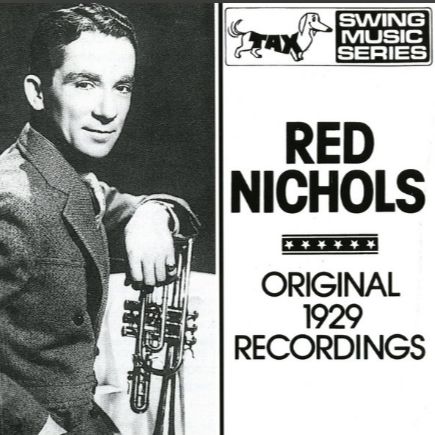Red Nichols, trait d’union entre la Nouvelle-Orléans et le swing
Parmi les figures fondatrices du jazz, Loring ‘Red’ Nichols occupe une place singulière, celle d’un passeur entre les traditions du Dixieland et les formes plus structurées du swing. Trompettiste, cornettiste et compositeur d’une précision remarquable, Red Nichols incarne l’esprit d’un jazz en transition, à la fois ancré dans les racines de La Nouvelle-Orléans et tourné vers la sophistication orchestrale des années 1930.
Né en 1905 à Ogden, dans l’Utah, il découvre très jeune la musique grâce à son père, chef d’orchestre, avant d’être profondément influencé par les premiers enregistrements de l’Original Dixieland Jass Band et par le style lyrique de Bix Beiderbecke. Dès ses débuts dans les orchestres du Midwest, il se distingue par un jeu limpide, articulé et d’une maîtrise technique rare. En 1923, il s’installe à New York, ville alors en pleine effervescence musicale, où sa carrière prend un essor décisif.
C’est là qu’il rencontre le tromboniste Miff Mole, avec qui il formera un duo légendaire. Ensemble, ils fondent en 1926 le groupe Red Nichols and His Five Pennies. Le nom prête à sourire, car leurs formations dépassent souvent la dizaine de musiciens. Mais quelles formations! Autour de Nichols gravitent des talents qui façonneront l’histoire du jazz: Benny Goodman, Jimmy Dorsey, Glenn Miller, Jack Teagarden ou encore Gene Krupa. Entre 1926 et 1932, ils enregistrent plus de 100 titres, contribuant à codifier un style où la rigueur de l’arrangement se marie à l’élan de l’improvisation.
Leur répertoire, d’une étonnante variété, s’étend de la tradition néo-orléanaise à des compositions plus orchestrées, annonçant l’ère du swing. L’interprétation de Ida, Sweet as Apple Cider remporte un immense succès et s’écoule à plus d’un million d’exemplaires, un exploit rare pour un morceau de jazz instrumental à l’époque.
La montée du swing et des grandes formations dans les années 1930 relègue toutefois son style plus intime au second plan. Après un retrait temporaire, il revient sur scène après la Seconde Guerre mondiale, formant un nouvel ensemble et jouant dans les clubs de Los Angeles avant de partir en tournée en Europe sous l’égide du Département d’État américain.
Red Nichols décède en 1965, mais son héritage perdure, notamment grâce au film The Five Pennies (1959) réalisé par Melville Shavelson, avec Danny Kaye dans son rôle. Ce biopic, nommé quatre fois aux Oscars, célèbre autant le musicien que l’homme, discret mais visionnaire.
Red Nichols, vínculo entre Nueva Orleans y el swing
Entre las figuras fundadoras del jazz, Loring “Red” Nichols ocupa un lugar singular, el de un puente entre las tradiciones del Dixieland y las formas más estructuradas del swing. Trompetista, cornetista y compositor de una precisión notable, Red Nichols encarna el espíritu de un jazz en transición, anclado en las raíces de Nueva Orleans y orientado hacia la sofisticación orquestal de los años treinta.
Nacido en 1905 en Ogden, Utah, descubrió la música muy joven gracias a su padre, director de orquesta, y quedó profundamente influido por las primeras grabaciones de la Original Dixieland Jass Band y por el estilo lírico de Bix Beiderbecke. Desde sus inicios en las orquestas del Medio Oeste, se distinguió por un sonido claro, articulado y de una maestría técnica poco común. En 1923 se trasladó a Nueva York, una ciudad entonces en plena efervescencia musical, donde su carrera tomó un impulso decisivo.
Allí conoció al trombonista Miff Mole, con quien formó un dúo legendario. Juntos fundaron en 1926 el grupo Red Nichols and His Five Pennies. El nombre resultaba irónico, ya que sus formaciones solían superar la decena de músicos. ¡Pero qué formaciones! En torno a Nichols gravitaban talentos que marcarían la historia del jazz: Benny Goodman, Jimmy Dorsey, Glenn Miller, Jack Teagarden o Gene Krupa. Entre 1926 y 1932 grabaron más de cien temas, contribuyendo a codificar un estilo en el que el rigor del arreglo se fusionaba con el impulso de la improvisación.
Su repertorio, de asombrosa variedad, abarcaba desde la tradición de Nueva Orleans hasta composiciones más orquestadas, anunciando la era del swing. La interpretación de Ida, Sweet as Apple Cider alcanzó un enorme éxito, vendiendo más de un millón de copias, un logro excepcional para una pieza instrumental de jazz en aquella época.
El auge del swing y de las grandes formaciones en los años treinta relegó, sin embargo, su estilo más íntimo a un segundo plano. Tras un retiro temporal, regresó a los escenarios después de la Segunda Guerra Mundial, formando un nuevo conjunto y actuando en clubes de Los Ángeles antes de embarcarse en una gira europea bajo el patrocinio del Departamento de Estado estadounidense.
Red Nichols falleció en 1965, pero su legado perdura, especialmente gracias a la película The Five Pennies (1959), dirigida por Melville Shavelson, con Danny Kaye en su papel. Este biopic, nominado a cuatro premios Óscar, celebra tanto al músico como al hombre, discreto pero visionario.
Red Nichols, anello di congiunzione tra New Orleans e lo swing
Tra le figure fondatrici del jazz, Loring “Red” Nichols occupa un posto singolare, quello di un ponte tra le tradizioni del Dixieland e le forme più strutturate dello swing. Trombettista, cornettista e compositore di notevole precisione, Red Nichols incarna lo spirito di un jazz in transizione, ancorato alle radici di New Orleans e proteso verso la sofisticazione orchestrale degli anni Trenta.
Nato nel 1905 a Ogden, nello Utah, scoprì la musica in giovane età grazie al padre, direttore d’orchestra, e fu profondamente influenzato dalle prime registrazioni della Original Dixieland Jass Band e dallo stile lirico di Bix Beiderbecke. Fin dagli esordi nelle orchestre del Midwest si distinse per un suono limpido, articolato e di rara padronanza tecnica. Nel 1923 si trasferì a New York, città allora in piena effervescenza musicale, dove la sua carriera conobbe una svolta decisiva.
Fu lì che incontrò il trombonista Miff Mole, con il quale formò un duo leggendario. Insieme fondarono nel 1926 il gruppo Red Nichols and His Five Pennies. Il nome poteva far sorridere, poiché le loro formazioni superavano spesso la decina di musicisti. Ma che formazioni! Attorno a Nichols gravitavano talenti destinati a segnare la storia del jazz: Benny Goodman, Jimmy Dorsey, Glenn Miller, Jack Teagarden e Gene Krupa. Tra il 1926 e il 1932 incisero oltre cento brani, contribuendo a codificare uno stile in cui il rigore dell’arrangiamento si fondeva con l’impeto dell’improvvisazione.
Il loro repertorio, di sorprendente varietà, spaziava dalla tradizione di New Orleans a composizioni più orchestrali, anticipando l’era dello swing. L’interpretazione di Ida, Sweet as Apple Cider ottenne un successo enorme, vendendo più di un milione di copie — un risultato eccezionale per un brano strumentale di jazz all’epoca.
L’ascesa dello swing e delle grandi orchestre negli anni Trenta relegò tuttavia il suo stile più intimo in secondo piano. Dopo un periodo di pausa, tornò sulle scene dopo la Seconda guerra mondiale, formando un nuovo ensemble e suonando nei club di Los Angeles, prima di partire per una tournée europea sotto l’egida del Dipartimento di Stato americano.
Red Nichols morì nel 1965, ma la sua eredità perdura, grazie soprattutto al film The Five Pennies (1959), diretto da Melville Shavelson, con Danny Kaye nel suo ruolo. Questo biopic, candidato a quattro premi Oscar, celebra tanto il musicista quanto l’uomo, discreto ma visionario.
Red Nichols, a bridge between New Orleans and swing
Among the founding figures of jazz, Loring “Red” Nichols occupies a unique place—as a bridge between the traditions of Dixieland and the more structured forms of swing. A trumpeter, cornetist, and composer of remarkable precision, Red Nichols embodied the spirit of a jazz in transition, rooted in the legacy of New Orleans yet reaching toward the orchestral sophistication of the 1930s.
Born in 1905 in Ogden, Utah, he discovered music at an early age thanks to his father, a bandleader, and was deeply influenced by the early recordings of the Original Dixieland Jass Band and by the lyrical style of Bix Beiderbecke. From his beginnings in Midwest orchestras, he stood out for his clear, articulate tone and rare technical mastery. In 1923, he moved to New York, a city then alive with musical excitement, where his career took a decisive turn.
There he met trombonist Miff Mole, with whom he formed a legendary duo. Together they founded Red Nichols and His Five Pennies in 1926. The name was somewhat ironic, as their ensembles often exceeded ten musicians. But what ensembles they were! Around Nichols gathered talents who would shape the very history of jazz: Benny Goodman, Jimmy Dorsey, Glenn Miller, Jack Teagarden, and Gene Krupa. Between 1926 and 1932, they recorded more than one hundred tracks, helping to codify a style in which the rigor of arrangement met the spontaneity of improvisation.
Their repertoire, strikingly diverse, ranged from New Orleans tradition to more orchestrated compositions, foreshadowing the swing era. Their rendition of Ida, Sweet as Apple Cider achieved enormous success, selling over a million copies—an exceptional feat for an instrumental jazz piece at the time.
The rise of swing and large orchestras in the 1930s, however, pushed his more intimate style into the background. After a brief hiatus, he returned to the stage following World War II, forming a new group and performing in Los Angeles clubs before embarking on a European tour under the auspices of the U.S. Department of State.
Red Nichols passed away in 1965, but his legacy endures—most notably through the film The Five Pennies (1959), directed by Melville Shavelson and starring Danny Kaye in his role. This biopic, nominated for four Academy Awards, celebrates both the musician and the man—discreet yet visionary.


